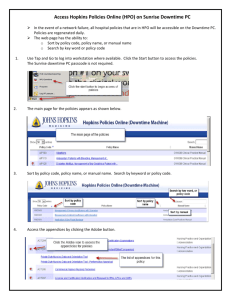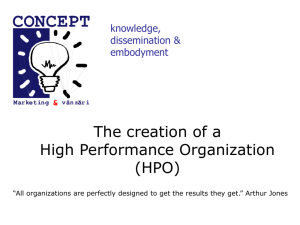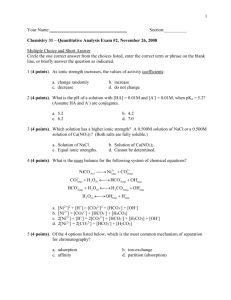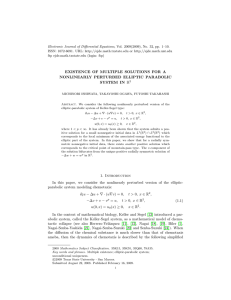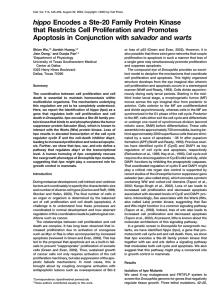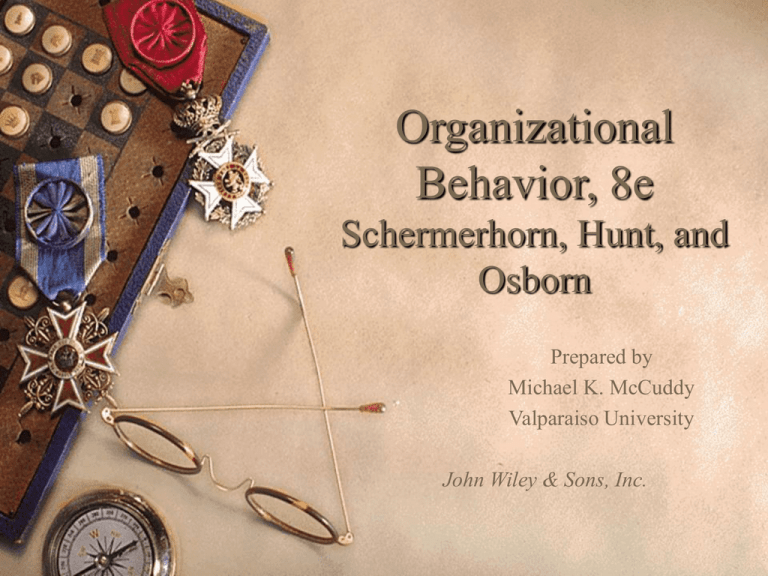
Organizational
Behavior, 8e
Schermerhorn, Hunt, and
Osborn
Prepared by
Michael K. McCuddy
Valparaiso University
John Wiley & Sons, Inc.
COPYRIGHT
Copyright 2003 © John Wiley & Sons, Inc. All rights reserved.
Reproduction or translation of this work beyond that permitted in Section
117 of the 1976 United States Copyright Act without the express written
permission of the copyright owner is unlawful. Request for further
information should be addressed to the Permissions Department, John Wiley
& Sons, Inc. The purchaser may make back-up copies for his/her own use
only and not for distribution or resale. The Publisher assumes no
responsibility for errors, omissions, or damages, caused by the use of these
programs or from the use of the information contained herein.
Organizational Behavior: Chapter 2
2
Chapter 2
The High Performance Organization
Study questions.
– What is the high performance context of
organizational behavior?
– What is a high performance organization?
– What are the management challenges of high
performance organizations?
– How do high performance organizations
operate?
Organizational Behavior: Chapter 2
3
What is the high performance context
of organizational behavior?
OB and changing customer expectations
– Total Quality Management (TQM).
• Meeting customer needs.
• Doing tasks right the first time.
– Continuous improvement.
• Is this necessary?
• If so, can it be done better?
Organizational Behavior: Chapter 2
4
What is the high performance context
of organizational behavior?
OB and changing customer expectations —
cont.
– Upside-down pyramid view of organizations.
• Customers and clients at the top of organization.
• Workers directly affect customers and clients.
• Team leaders and middle managers directly support
the workers.
• Top managers clarify the mission and objectives,
set strategies, and make adequate resources
available.
Organizational Behavior: Chapter 2
5
What is the high performance context
of organizational behavior?
OB and the changing workforce.
– Increasing workforce diversity in:
• United States.
• Canada.
• European Union.
– Generation X (or Gold-Collar workers).
– Poor educational preparation of some high
school graduates.
Organizational Behavior: Chapter 2
6
What is the high performance context
of organizational behavior?
Generation X workers.
– Desire empowerment.
– These desires are strongest for knowledge
workers.
– Have a high level of skills and abilities for
functioning well in challenging jobs and work
settings.
Organizational Behavior: Chapter 2
7
What is the high performance context
of organizational behavior?
Ill-prepared high school graduates.
– Enter the workforce with significant skill
deficiencies.
– Need for remedial training.
• High cost to organizations.
• Individuals can suffer long-term career
disadvantages.
Organizational Behavior: Chapter 2
8
What is the high performance context
of organizational behavior?
OB and changing organizations.
– Changes in the way people work.
• Stresses of downsizing and restructuring.
• Impact of information technology.
• New meanings in employer-employee
relationships.
Organizational Behavior: Chapter 2
9
What is the high performance context
of organizational behavior?
OB and changing organizations — cont.
– Process reengineering.
• Rethinks and radically redesigns business
processes to stimulate innovation and change and
improve performance.
– Electronic commerce.
• Transaction of business through the Internet.
• E-corporations.
Organizational Behavior: Chapter 2
10
What is the high performance context
of organizational behavior?
OB and changing organizations — cont.
– Free agent economy.
– Shamrock organizations.
• Relatively small core group of permanent, full-time
employees with critical skills.
• Outside operators contracting to core group to
perform essential daily activities.
• Part-timers hired by core group on an as-needed
basis.
Organizational Behavior: Chapter 2
11
What is a high performance
organization?
High performance organizations (HPOs).
– HPOs intentionally designed to:
• Bring out the best in people.
• Produce organizational capability that delivers
sustainable organizational results.
– HPOs place people first.
Organizational Behavior: Chapter 2
12
What is a high performance
organization?
Emphasis on intellectual capital.
– Intellectual capital is the foundation for HPOs.
– To utilize intellectual capital, HPOs often
organize work-flow around key business
processes and use work teams within these
processes.
Organizational Behavior: Chapter 2
13
What is a high performance
organization?
Key components utilized in HPOs.
– Employee involvement.
– Self-directing work teams.
– Integrated production technologies.
– Organizational learning.
– Total quality management.
Organizational Behavior: Chapter 2
14
What is a high performance
organization?
Employee involvement.
– The amount of decision making delegated to
workers at all levels.
– Employment involvement can be visualized on
a continuum.
• No involvement or parallel involvement.
• Moderate involvement or participative
management.
• High involvement or employee empowerment.
Organizational Behavior: Chapter 2
15
What is a high performance
organization?
Self-directing work teams.
– Empowered to make decisions about planning,
doing, and evaluating their work.
– Sometimes called self-managing or selfleading work teams.
– Important in HPOs due to:
• Need to tap employees’ expertise and knowledge.
• Need for employees to manage themselves.
Organizational Behavior: Chapter 2
16
What is a high performance
organization?
Integrated production technologies.
– Focus on providing flexibility in
manufacturing and services and involves job
design and information technology.
– Key components:
• Just-in-time systems.
• Use of computers.
Organizational Behavior: Chapter 2
17
What is a high performance
organization?
Organizational learning.
– A way for organizations to adapt to their
settings and to gather information to anticipate
future changes.
– HPOs are designed for organizational learning.
Organizational Behavior: Chapter 2
18
What is a high performance
organization?
Total quality management (TQM).
– A total commitment to:
• High-quality results.
• Continuous improvement.
• Meeting customer needs.
– TQM is a a tightly integrated part of HPOs.
• Encourages all workers to do their own quality
planning and checking.
Organizational Behavior: Chapter 2
19
What are the management challenges of
high performance organizations?
Challenges of environmental linkages.
– HPOs are open systems influenced by a
rapidly moving external environment.
– Open systems components.
• Inputs: worksite problems and opportunities, and
vision, mission, and strategy.
• Transformation processes: five HPO components.
• Outputs: individual, group, and organizational
effectiveness, and contributions.
Organizational Behavior: Chapter 2
20
What are the management challenges of
high performance organizations?
Challenges of internal integration.
– Challenge of integrating five HPO
components.
– Top-down and bottom-up decision making in
HPOs.
– HPO islands.
Organizational Behavior: Chapter 2
21
What are the management challenges of
high performance organizations?
Challenges for middle manager roles.
– Helping implement HPO components.
– HPO changes may alter middle managers’
jobs.
– Dealing with employee resistance to selfmanaging teams.
– Resolving tensions among HPO components.
Organizational Behavior: Chapter 2
22
What are the management challenges of
high performance organizations?
Challenges for high level leadership.
– Deciding how far to go in becoming a HPO.
– Internationalizing United States business
practices.
Organizational Behavior: Chapter 2
23
What are the management challenges of
high performance organizations?
Challenges of greenfield sites versus
redesigns.
– Greenfield sites start from scratch at a new
site.
– Redesigns start as more traditional
organizations and change toward HPOs.
– Greenfield sites result in better financial
performance for organizations.
Organizational Behavior: Chapter 2
24
How do high performance
organizations operate?
Southwest Airlines as an HPO.
– HPO component: employee involvement.
• Flat and lean hierarchy.
• Heavy team emphasis throughout organization.
• Paper work minimized.
• Rapid decision making emphasized.
• People were empowered to do “whatever it takes”
to get the job done.
Organizational Behavior: Chapter 2
25
How do high performance
organizations operate?
Southwest Airlines as an HPO.
– HPO component: self-directing work teams.
• Longer term service teams.
• Ad hoc teams for given projects or duties.
• Culture promotes cooperative activities.
Organizational Behavior: Chapter 2
26
How do high performance
organizations operate?
Southwest Airlines as an HPO.
– HPO component: integrated production
technologies.
• Integrated use of information technology in
distribution, order entry, crew pairings, dispatching
of flights, revenue management, schedule planning,
and parts replacement.
Organizational Behavior: Chapter 2
27
How do high performance
organizations operate?
Southwest Airlines as an HPO.
– HPO component: organizational learning.
• Deeply rooted in Southwest’s culture.
• Letters and newsletters about company business.
• Managers encourage workers to spend time at jobs
other than their own.
• Southwest’s “University for People.”
Organizational Behavior: Chapter 2
28
How do high performance
organizations operate?
Southwest Airlines as an HPO.
– HPO component: total quality management.
• “Southwest Spirit” focusing on a strong work
ethic, a strong desire for quality work, going
beyond the call of duty, helping others, and doing
the “right” thing.
• TQM qualities are reinforced by empowerment,
learning, and communications devices.
Organizational Behavior: Chapter 2
29
How do high performance
organizations operate?
Southwest Airlines as an HPO.
– Other HPO considerations: vision/direction
setting package.
• “The mission of Southwest Airlines is dedication to
the highest quality of Customer Service delivered
with a sense of warmth, friendliness, individual
pride, and Company Spirit.”
• Strategic elements in direction setting.
• Core values.
Organizational Behavior: Chapter 2
30
How do high performance
organizations operate?
Southwest Airlines as an HPO.
– Other HPO considerations: the people.
• Attitude reflecting “Southwest Spirit” is a key
hiring requirement.
• Attitude more important than other hiring
qualifications.
Organizational Behavior: Chapter 2
31
How do high performance
organizations operate?
Southwest Airlines as an HPO.
– Other HPO considerations: compensation.
• Flight attendants paid by the trip.
• Incentives for employee performance.
• Pilots’ salaries are comparable to other airlines but
they fly 40% more hours.
• Profit sharing and pension plans.
• Usual airline fringe benefits.
Organizational Behavior: Chapter 2
32
How do high performance
organizations operate?
Southwest Airlines as an HPO.
– Other HPO considerations: dealing with the
environment.
• Southwest flourishes in a deregulated environment.
• Southwest’s HPO attributes serve it well in dealing
with a highly competitive environment.
Organizational Behavior: Chapter 2
33
How do high performance
organizations operate?
Southwest Airlines as an HPO.
– Other HPO considerations: outcomes.
• Highly satisfied employees.
• Strong commitment to the company.
• Low turnover.
• Strong performance on various productivity
measures.
• Active in contributing to the communities in which
it operates.
Organizational Behavior: Chapter 2
34

